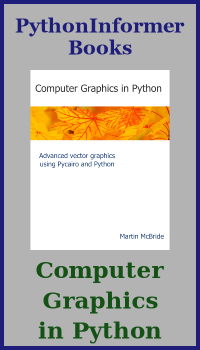Multidimensional collections
Categories: magic methods

In the article on magic methods for collections we saw how to implement collection behaviours for our example matrix class. We implemented support of built-in function len, support for for loops and the in operator. We also saw how to might implement del, although our 2 by 2 matrix doesn't allow it.
For getting and setting elements, we implemented __getitem__ and __setitem__ as if the matrix was a list of 4 elements. In thi sarticle we will see how to improve that.
Supporting two dimensional selection
Our Matrix is a 2D array, so wouldn't it be nice to support (row, column) style selection? It would be nice if we could use a syntax like:
a[0, 1] #row 0, columns 1
Well we can! The numpy library does exactly this, and we can easily support this with our Matrix class.
If you are familiar with dictionaries, you will know that a dictionary is indexed by keys rather than integers. A key can be an integer, or a string, but it can also be a tuple:
d = dict()
d[0] = 0
d['two'] = 2
d[(0, 1)] = 3
print(d)
This gives the result:
{0: 0, 'two': 2, (0, 1): 3}
Thanks to the magic of tuple packing we can write d[(0, 1)] as d[0, 1]. So we can do this:
d[0, 1] = 10
print(d)
which gives:
{0: 0, 'two': 2, (0, 1): 10}
We need to do a similar thing with our matrix class.
Two dimensional getters and setters
Previously our getter and setter accepted and index of the item in list of length 4:
def __getitem__(self, i):
return self.data[i]
But now instead we want to pass in a tuple (row, col). So we need to modify our code like this:
def __getitem__(self, t):
row, col = t
return self.data[row*2 + col]
We can now do this:
m = Matrix(1, 2, 3, 4)
print(m[1, 0])
This prints matrix row 1, column 0, which is the value 3.
We can do a similar thing with the setter:
def __setitem__(self, t, value):
row, col = t
self.data[row*2 + col] = value
which allows us to do this:
m[0, 1] = 5
print(m)
The matrix has now been updated, with row 0 column 1 set to 5:
[1, 5][3, 4]
Related articles
Join the GraphicMaths/PythonInformer Newsletter
Sign up using this form to receive an email when new content is added to the graphpicmaths or pythoninformer websites:

Popular tags
2d arrays abstract data type and angle animation arc array arrays bar chart bar style behavioural pattern bezier curve built-in function callable object chain circle classes close closure cmyk colour combinations comparison operator context context manager conversion count creational pattern data science data types decorator design pattern device space dictionary drawing duck typing efficiency ellipse else encryption enumerate fill filter for loop formula function function composition function plot functools game development generativepy tutorial generator geometry gif global variable greyscale higher order function hsl html image image processing imagesurface immutable object in operator index inner function input installing integer iter iterable iterator itertools join l system lambda function latex len lerp line line plot line style linear gradient linspace list list comprehension logical operator lru_cache magic method mandelbrot mandelbrot set map marker style matplotlib monad mutability named parameter numeric python numpy object open operator optimisation optional parameter or pandas path pattern permutations pie chart pil pillow polygon pong positional parameter print product programming paradigms programming techniques pure function python standard library range recipes rectangle recursion regular polygon repeat rgb rotation roundrect scaling scatter plot scipy sector segment sequence setup shape singleton slicing sound spirograph sprite square str stream string stroke structural pattern symmetric encryption template tex text tinkerbell fractal transform translation transparency triangle truthy value tuple turtle unpacking user space vectorisation webserver website while loop zip zip_longest
